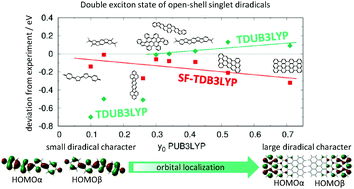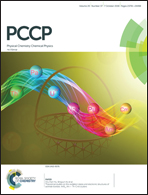The double exciton state of conjugated chromophores with strong diradical character: insights from TDDFT calculations†
Abstract
A peculiar characteristic of open-shell singlet diradical molecules is the presence of a double exciton state (H,H → L,L) among low lying excited states. Recent high-level quantum-chemical investigations including a static and dynamic electron correlation have demonstrated that this state can become the lowest singlet excited state, a diagnostic fingerprint of the diradical system. Here we investigate the performance of less computationally demanding TDDFT calculations by employing two approaches: the spin-flip TDDFT scheme and TD calculations based on unrestricted broken symmetry antiparallel-spin reference configuration (TDUDFT). The calculations are tested on a number of recently synthesized, large conjugated systems displaying from moderate to large diradical character and showing experimental trace of the double exciton state. We show that spin-flip (SF) TDB3LYP calculations in the collinear approximation generally underestimate the excitation energy of the double exciton state. When the molecule displays a strong diradical character, the unrestricted antiparallel-spin reference configuration of TDUDFT calculations is characterized by strongly localized frontier molecular orbitals. We show that under these conditions the double exciton state is captured by TDUB3LYP calculations since it is described by singly excited configurations and its excitation energy can be accurately predicted. Owing to the improved description of the ground state, also the excitation energy of the single exciton H → L state generally improves at the TDUB3LYP level. With regard to the double exciton state, SF TDB3LYP performs slightly better for small to medium diradical character while a large diradical character (and strong orbital localization) is a prerequisite for the success of TDUB3LYP calculations whose quality otherwise deteriorates.



 Please wait while we load your content...
Please wait while we load your content...